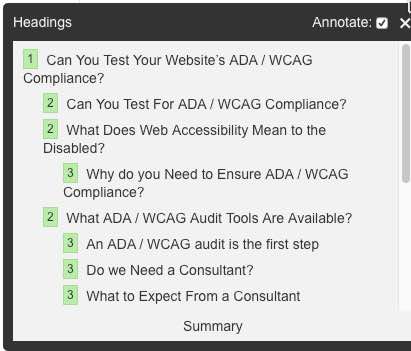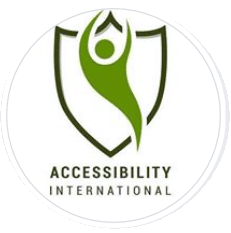Can You Test Your Website for Accessibility Compliance?
The courts have established that almost all websites are considered “places of public accommodation” and subject to the American Disabilities Act. In Addtion any institution receiving federal funding must ensure that their websites comply with Sect 508 of the Rehabilitation Act.
What Does Web Accessibility Mean to the Disabled?
Most of us are familiar with how Accessibility applies to physical business places. However, little thought has been given to how Accessibility applies to the Internet. Accessibility on the World Wide Web demands that we break down barriers and open a clear path for everyone.
This means that web pages must be designed so that those with Visual, Hearing, Motor and Cognitive disabilities have an equal opportunity to navigate and access every web page.
Why do you Need to Ensure ADA / WCAG Compliance?
The Web Content Accessibility Guideline (WCAG) is the standard that currently measures compliance in both cases. Failure to embrace voluntary compliance could open the door for litigation to enforce making your site accessible.
3 Steps You Need to Take to a Successful Web Accessibility Audit
The recommended best practice includes the following three steps to establish a complete ADA compliance audit.
An ADA / WCAG Audit is the First Step
What is the first step in making your website Sect 508 or ADA compliant? As your first step, you need to conduct a WCAG 2.0 audit. While you can use automated WCAG testing tools perform your initial test, WCAG testing software will catch less that a quarter of potential issues.
Its very important not to rely only on automated testing and auditing tools alone. The Web Content Accessibility Guidelines, are just that – they just provide a guide to acheiving web accessibility. It may be nuanced and interpretive, however it requires a human assessment.
Is it Best to Hire a Web Accessibility Specialist?
It’s not mandated, however hiring a web accessibility consultant is the preferred option. When hiring such a firm or individual, you’ll want to first become comfortable with their experience in both WCAG auditing as well as coding.
Its essential that they understand your code. Its also important to know that the reporting you will get from their audit will fully serve your needs.
What Should You Expect From Your Accessibility Consultant?
It won’t help you if you simply get a list of issues. That won’t really help you. A good accessibility consultant will provide actionable reporting that doesn’t just point out your problems.
They will also give you point by point remediation guidance that your developer can use. The format of the documentation you receive is very important.
A ‘Word doc’ may be nice for management. However a Word doc would be useless for your remediation team. Your remediation team should get an ‘Excel spreadsheet’ with an item by item report. This type of report can in turn be used to determine their targets and how to develop a workflow designed to meet their goals.
Your 3 Steps to a Successful Web Accessibility Audit
Automated Testing is Step One to Accessibility Compliance
There are many different types of automated testing tools available to reach ADA or Sect 508 compliance. You have to understand the difference between page testers and site auditors.
The free Wave web accessibility evaluation tool is a page tester and will not actually audit your website. However, they are great to give you some idea of the scope of the issues you have to deal with. You shouldn’t rely on automated testing alone, because these tools will only capture roughly 25% of issue types.
WCAG compliance is interpretive and nuanced, not something rigid and easily diagnosed by an automated evaluation tool.
Performing Code Review is the Next Step To Accessibility Compliance
Here someone with an understanding of both WCAG 2.0 and website code can catch what is missed by automated web accessibility evaluation testing. Typically this person will identify the unique pages and templates of a site and only manually audit these. It would be cost prohibitive to manually review every page of a site.
Actual Assistive Technology Tools Test for Accessibility Compliance
For those seeking the most thorough accessibility, the tester will use the actual tools used by those with disabilities to use the website. These include JAWS, ZOOM Text, NVDA, Dragon Natural Speaking, and many other tools available to aid the disabled.
Its very important to realize that the standards are interpretive. Manual testing is key.
My Choice to Build Web Accessibility Into My Sites
It’s a simple choice really, expose your business to litigation because of problems with Accessibility, or build your sites differently. A good Content Management system can help you avoid most Accessibility pitfalls and make your life easier.
I choose to build my sites using the DIVI theme by Elegant Themes which uses WordPress as it’s CMS.

DIVI Builds Your Sites With Accessibility Testing Embedded
The image above shows the embedded DIVI Headings Checker which I use to test my Headings for Web Accessibility. Using DIVI is quick and painless, using modules to build your site one piece at a time.
Each module walks you through the complete process to ensure compliance with Accessibility issues. DIVI is flexible in how it works, allowing you to design your site to be both visually pleasing and Accessibility compliant.



